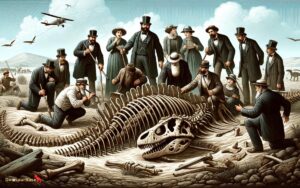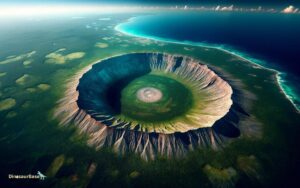Are Dinosaur Eggs Real? Unveiling Prehistoric Mysteries!
Yes, dinosaur eggs are real and have been discovered by paleontologists worldwide. Evidence of these ancient reproductive objects provides insight into the behavior and development of dinosaurs.
Roughly 200 million years of prehistory witnessed the dominance of dinosaurs, magnificent creatures whose legacy continues to fascinate us. Fossilized dinosaur eggs serve as a bridge to this distant past, giving scientists valuable information about the life cycles and nesting habits of these extinct animals.
Found in clusters or as single specimens, these petrified eggs open a window into the reproductive strategies of various dinosaur species. Each discovery adds a piece to the puzzle of how these colossal beings proliferated and interacted with their environments. Collectively, the study of dinosaur eggs enriches our understanding of evolutionary biology and the Earth’s geological history.

Credit: littlevillagestore.com

The Reality Of Dinosaur Eggs
Imagine walking in the footsteps of creatures that roamed the Earth millions of years ago. Among the most astounding traces they left behind are dinosaur eggs. Yes, dinosaur eggs are not just in movies; they were once real and part of the circle of life during the Mesozoic Era.
Fossilized Evidence
Scientists have unearthed stony shells that tell a tale of ancient life. These are not just rocks but fossilized eggs, hardened over time. Inside, the bones of embryonic dinosaurs often give clues about species and development. Museums showcase these wonders, allowing us a window into a prehistoric world.
- Calcified for preservation
- Contained embryo remains
- Evidence of nesting behaviors
Places Of Discovery
Fossilized dinosaur eggs have surfaced across the globe. Each discovery brings excitement and knowledge.
| Location | Significance |
|---|---|
| Mongolia | First discovery of dinosaur eggs |
| China | Rich in egg fossils |
| Argentina | Home to some of the largest eggs |
| France | Insight into nesting sites |
Each location contributes to our understanding of these ancient creatures.
Formation And Preservation
Dinosaur eggs, long buried and turned to stone, were once real. These ancient treasures provide a window into prehistoric life. They show us how dinosaurs reproduced and cared for their young. Understanding how dinosaur eggs formed and preserved teaches us about Earth’s past climates and geography.
The Fossilization Process
When a dinosaur laid an egg millions of years ago, fossilization began under specific conditions. First, the egg needed quick burial. Layers of sediment protected it from scavengers and the elements. Over time, minerals replaced the organic materials in the eggshell, transforming it into stone. This process is both rare and incredible.
Geological Factors Contributing To Preservation
Several geological factors played a role in preserving dinosaur eggs. Stable conditions were crucial.
- Minimal erosion ensured eggs stayed buried.
- Constant sedimentation rates helped maintain coverage.
- A lack of volcanic activity prevented destruction.
Unearthing The Past
Dinosaurs, colossal beings that once roamed our planet, left behind more than just fossilized bones. Nestled within the layers of the Earth, remnants of their very beginning—their eggs—rest in silence, waiting to tell a prehistoric tale. Discoveries of dinosaur eggs have not only validated their existence but also opened a portal into understanding their enigmatic lives.
Key Archaeological Finds
The search for dinosaur eggs has yielded extraordinary finds across the globe. Key discoveries include:
- Argentina’s Patagonia: a treasure trove of over a hundred eggs with embryonic remains.
- China’s Heyuan City: home to thousands of eggs and recognized as the ‘Dinosaur Egg Capital of the World’.
- Mongolia’s Gobi Desert: where nests complete with clutches of eggs paint a vivid picture of dinosaur parenting.
Methods Of Excavation And Analysis
To unearth these prehistoric gems, experts employ meticulous methods:
- Identifying potential dig sites using satellite images and ground-penetrating radar.
- Carefully extracting the eggs using tools like brushes, and chisels.
- Analyzing eggshells and contents with advanced technologies such as CT scans and X-rays.
These approaches provide invaluable insights into dinosaur reproduction, growth, and evolution.

Credit: legacytoys.com
Insights From The Shell
Imagine holding a piece of prehistoric life in your hands. That’s exactly what you do when you touch a dinosaur egg. Dinosaur eggs are real and have a lot to tell us. Each fossilized shell is a treasure trove of secrets, offering vivid snapshots into the lives of dinosaurs. So let’s dive in and explore the ‘Insights from the Shell’.
Structure And Composition
Dinosaur eggshells give us valuable insights into the makeup of these ancient wonders. They are composed mainly of calcium carbonate, similar to the eggs of modern birds and reptiles. The structure of the shell tells us about the egg’s strength and flexibility, vital for the protection of the developing embryo.
Scientists use high-powered microscopes to examine the microstructure of these shells. They look at characteristics such as:
- Porosity
- Thickness
- Layering
These factors can reveal how a dinosaur egg could survive in its environment. The eggs of larger dinosaurs often had thicker shells, suggesting a need for more protection. The level of porosity indicates how air and moisture could pass through, affecting the embryo’s development.
Clues To Dinosaur Behavior And Environment
The composition of a dinosaur eggshell can also shed light on the dinosaur’s behavior and environment. For instance, the presence of certain minerals can tell us about the conditions where the egg was laid.
Here are some behaviors and environmental factors that scientists often interpret from the shells:
| Shell Feature | Behavioral Insight | Environmental Clue |
|---|---|---|
| Shell Thickness | Parental Care | Harsh Conditions |
| Nesting Patterns | Social Behavior | Nesting Grounds |
| Incubation Marks | Growth Rates | Seasonal Cycles |
Eggshell fragments sometimes show signs of nesting patterns that suggest community behavior among dinosaurs. This could imply that dinosaurs may have lived and raised their young in groups. On top of that, incubation marks can tell us about the growth rates of dinosaur embryos and whether they hatched in sync with seasonal cycles.
Dinosaur Eggs In Modern Science And Culture
The topic of dinosaur eggs captivates both scientists and the public alike. With their tough shells buried for ages, these ancient treasures offer a peek into prehistoric life. In science and culture, dinosaur eggs spark curiosity and inspire innovative concepts.
Technological Advancements In Paleontology
Today, paleontology leaps forward thanks to cutting-edge technology. Scientists use advanced scanning to unearth secrets inside fossilized eggs without damaging them. They discover tiny bones and even embryo positioning. Experts also leverage 3D printing to reconstruct eggs and hatchlings, offering a tangible glimpse into the past.
- CT Scanning: Reveals hidden structures within eggs.
- Synthetic Modeling: Creates three-dimensional replicas of delicate fossils.
- Digital Imaging: Enhances details beyond the naked eye.
The Influence On Pop Culture And Education
Dinosaur eggs have a mighty presence in movies, books, and games. This fascination educates and entertains. Children learn about ancient life through interactive exhibits and lifelike replications in museums. These encounters not only teach but also ignite young imaginations worldwide, fostering the next generation of paleontologists.
| Medium | Impact |
|---|---|
| Films | Bring dinosaurs to life on the big screen. |
| Books | Offer in-depth knowledge about prehistoric eras. |
| Educational Toys | Simulate fossil discovery and assembly. |

Credit: www.amazon.com
Conclusion
Discovering the truth about dinosaur eggs has been a captivating journey. These remarkable fossils are indeed real, unlocking prehistoric secrets for scientists and enthusiasts alike. As we’ve explored, their existence offers a direct link to an astonishing past. Keep the curiosity alive; the story of these ancient treasures continues with each new find.




